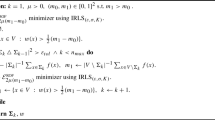Abstract
Generating terrain models from contour input is still an important process. Most methods have been unsatisfactory, as they either do not preserve the form of minor ridges and valleys, or else they are poor at modeling slopes. A method is described here, based on curve extraction and generalization techniques, that is guaranteed to preserve the topological relationships between curve segments. The skeleton, or Medial Axis Transform, can be extracted from the Voronoi diagram of a well-sampled contour map and used to extract additional points that eliminate cases of “flat triangles” in a triangulation. Elevation estimates may be made at these points. Based on this approach it is possible to make reasonable estimates of slopes for terrain models, and to extract meaningful intermediate points for triangulated irregular networks (TINs).
Similar content being viewed by others
References
H. Alt and O. Schwarzkopf. “The Voronoi diagram of curved objects,” Proceedings, 11th Annual ACM Symposium on Computational Geometry, 89–97, 1995.
N. Amenta, M. Bern, and D. Eppstein. “The crust and the beta-skeleton: combinatorial curve reconstruction,” Graphical Models and Image Processing, Vol. 60:125–135, 1998.
G. Aumann, H. Ebner, and L. Tang. “Automatic derivation of skeleton lines from digitized contours,” ISPRS Journal of Photogrammetry and Remote Sensing, Vol. 46:259–268, Elsevier Science Publishers B.V.: Amsterdam, 1991.
H. Blum. “A transformation for extracting new descriptors of shape,” in W. Whaten Dunn (Ed.), Models for the Perception of Speech and Visual Form. MIT Press: Cambridge, Mass., 153–171, 1967.
A. Carrara, G. Bitelli, and R. Carla. “Comparison of techniques for generating digital terrain models from contour lines,” International Journal of Geographical Information Science, Vol. 11:451–473, 1997.
A.B. Garcia, C.G. Nicieza, J.B.O. Meréé, and A.M. Diaz. “A contour line based triangulating algorithm,” Proceedings, 5th International Symposium on Spatial Data Handling, 273–284, 1990.
C.M. Gold. “Chapter 3—Surface interpolation, spatial adjacency and G.I.S,” in Three Dimensional Applications in Geographic Information Systems (J. Raper, Ed.), Taylor and Francis, Ltd.: London, 21-35, 1989.
C.M. Gold. “Simple topology generation from scanned maps,” Proceedings, Auto-Carto 13, ACM/ASPRS, Seattle, April, 337–346, 1997.
C.M. Gold. “The Quad-Arc data structure,” in Poiker, T.K. and Chrisman, N.R. (Eds.). Proceedings, 8th International Symposium on Spatial Data Handling, Vancouver, BC, 713–724, 1998.
C.M. Gold. “Crust and anticrust: a one-step boundary and skeleton extraction algorithm,” in Proceedings of the ACM Conference on Computational Geometry, Miami, Florida, 189–196, 1999.
C.M. Gold, J. Nantel, and W. Yang. “Outside-in: An alternative approach to forest map digitizing,” International Journal of Geographical Information Systems, Vol. 10:291–310, 1996.
C.M. Gold and J. Snoeyink. “A one-step crust and skeleton extraction algorithm,” Algorithmica, (in press).
L. Guibas and J. Stolfi. “Primitives for the manipulation of general subdivisions and the computation of Voronoi diagrams,” Transactions on Graphics, Vol. 4:74–123, 1985.
R.L. Ogniewicz. “Skeleton-space: a multiscale shape description combining region and boundary information,” Proceedings on Computer Vision and Pattern Recognition, 746–751, 1994.
R. Ogniewicz and M. Ilg. “Skeletons with euclidian metric and correct topology and their application in object recognition and document analysis,” Proceedings of the 4th International Symposium on Spatial Data Handling, Vol. 1:15–24, 1990.
A. Okabe, B. Boots, and K. Sugihara. Spatial Tessellations—Concepts and Applications of Voronoi Diagrams. John Wiley and Sons: Chichester. 1992.
G.J. Robinson. “The accuracy of digital elevation models derived from digitised contour data,” Photogrammetric Record, Vol. 14:805–814, 1994.
R. Weibel, M. Heller. “Digital terrain Modelling,” in Maguire, D.J., M.F. Goodchild, and D.W. Rhind, (Eds.) Geographical Information Systems: Principles and applications. Longman: London, 1990.
Author information
Authors and Affiliations
Rights and permissions
About this article
Cite this article
Thibault, D., Gold, C.M. Terrain Reconstruction from Contours by Skeleton Construction. GeoInformatica 4, 349–373 (2000). https://doi.org/10.1023/A:1026509828354
Issue Date:
DOI: https://doi.org/10.1023/A:1026509828354




